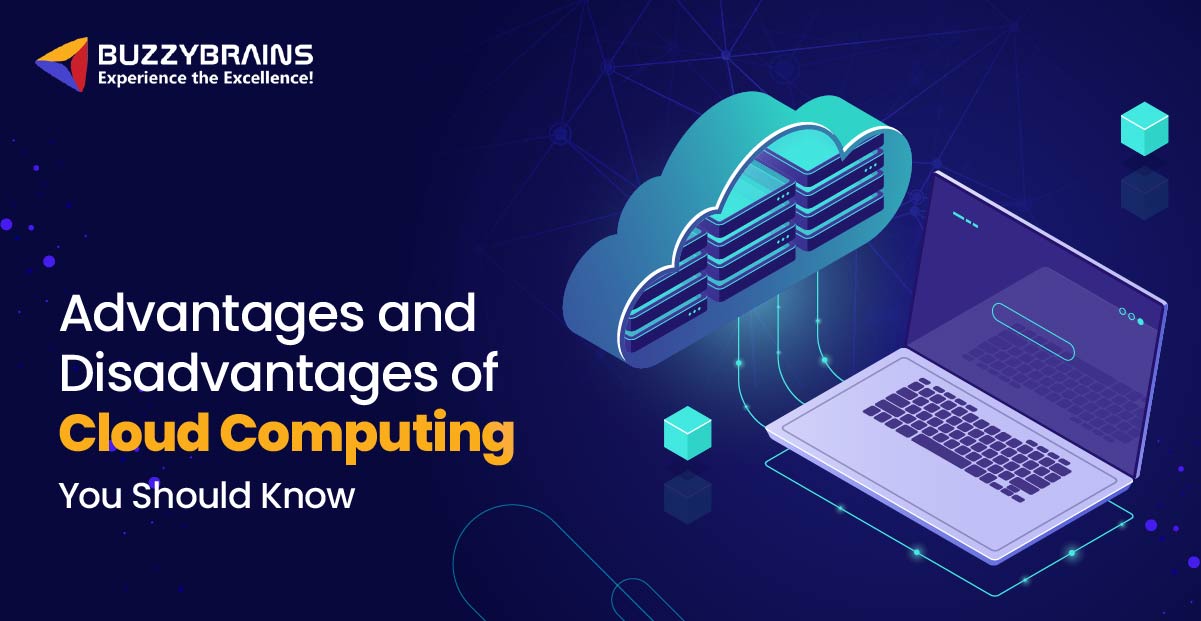Advantages and Disadvantages of Cloud Computing You Should Know

Cloud computing has changed how we use technology. It allows access to data and services from anywhere, at any time. This has made life easier for individuals and businesses alike.
But just like any other technology, it has its benefits and limitations. If you’re considering switching to the cloud, it’s important to understand both sides.
- What is Cloud Computing?
- Why Has Cloud Computing Gained Popularity?
- What are the Advantages and Disadvantages of Cloud Computing?
- Major Advantages of Cloud Computing
- Major Disadvantages of Cloud Computing
- Key Considerations Before Adopting Cloud Computing
- Who Should Use Cloud Computing?
- FAQs About Advantages and Disadvantages of Cloud Computing
- Conclusion
- Transform Your Business with Expert Cloud Computing Solutions from BuzzyBrains
What is Cloud Computing?
Cloud computing is the delivery of computing services over the internet. These services include storage, databases, servers, networking, software, and more. Instead of buying and maintaining physical servers, you can rent them from a cloud provider.
According to a report by Gartner, the global public cloud services market is expected to reach $1 Trillion by 2027. That’s because more organizations are adopting the cloud for flexibility, speed, and cost-effectiveness.
Some popular cloud service providers include Amazon Web Services (AWS), Microsoft Azure, and Google Cloud Platform (GCP).
Cloud computing services are typically categorized into three cloud models:
- IaaS (Infrastructure as a Service)
- PaaS (Platform as a Service)
- SaaS (Software as a Service)
Each model offers a different level of control and flexibility depending on your needs.
Why Has Cloud Computing Gained Popularity?
Cloud computing is popular for several reasons. One major factor is its ability to reduce upfront IT costs. Businesses no longer need to invest in expensive hardware.
Another reason is scalability. Companies can increase or decrease resources based on demand. This is especially useful for startups and growing businesses.
According to Flexera’s 2023 State of the Cloud Report, 94% of enterprises use cloud services. And around 61% of organizations plan to optimize existing use of the cloud for cost savings. These stats show how vital the cloud has become.
What are the Advantages and Disadvantages of Cloud Computing?
Cloud computing offers a lot of benefits. It simplifies access to technology. But it also has challenges like security and service outages.
Understanding both sides will help you make better decisions. Here, we break down the top pros and cons.
Major Advantages of Cloud Computing
Cloud computing offers many benefits that help businesses run better.
1. Cost Efficiency
One of the biggest advantages is reduced costs. You don’t have to buy expensive servers or maintain hardware. You pay only for what you use.
For small businesses, this is a game-changer. They can use enterprise-level services without a big budget.
2. Scalability and Flexibility
With cloud computing, you can scale up or down quickly. Need more storage or computing power? You can add it instantly.
This flexibility helps businesses respond to demand changes efficiently.
3. Accessibility and Remote Work
Cloud services can be accessed from anywhere. You only need an internet connection.
This has become crucial in the age of remote work. Teams can collaborate in real-time regardless of location.
4. Automatic Software Updates
Cloud providers handle maintenance and updates. This means you’re always using the latest version of software.
It saves time and ensures security patches are up to date.
5. Disaster Recovery
Data backup and recovery options are built into most cloud services. In case of hardware failure, your data remains safe.
This reduces downtime and prevents data loss.
6. Improved Collaboration
Team members can work on the same files simultaneously. Tools like Google Drive and Microsoft 365 make this easy.
This boosts productivity and streamlines communication.
7. Eco-Friendly Solution
Cloud computing can reduce energy consumption. Providers run optimized data centers that are more efficient than traditional servers.
Some providers also use renewable energy, reducing carbon footprints.
8. High Performance and Reliability
Cloud services run on global networks with fast infrastructure. This ensures high performance and reliability.
Many providers offer uptime guarantees of 99.9% or more.
Security Features
Most cloud platforms offer built-in security tools. These include encryption, firewalls, and compliance with regulations like GDPR.
Providers invest heavily in cybersecurity to protect user data.
10. Resource Management
Cloud dashboards help monitor usage and manage resources. You can track performance, optimize costs, and allocate resources effectively.
Major Disadvantages of Cloud Computing
While cloud computing offers many advantages, it also has drawbacks.
1. Security and Privacy Concerns
Storing data in the cloud raises security issues. There is a risk of unauthorized access and data breaches.
Highly regulated industries need to be extra cautious.
2. Downtime and Internet Dependency
Cloud services rely on the internet. If your connection is unstable, it affects access.
Also, cloud providers may face outages, affecting business operations.
3. Limited Control and Flexibility
Users have less control over back-end infrastructure. This may limit customization options.
You depend on the provider’s configurations and offerings.
4. Vendor Lock-In
Switching providers can be difficult. Different platforms have different architectures.
This can lead to high migration costs and technical challenges.
5. Ongoing Costs
While cloud reduces upfront investment, monthly bills can add up.
Unexpected charges for bandwidth or storage may increase total costs.
6. Data Transfer Bottlenecks
Transferring large amounts of data to and from the cloud can be slow.
This may affect application performance and increase wait times.
7. Compliance and Legal Risks
Data stored in other countries may be subject to foreign laws.
You must ensure compliance with data protection regulations.
8. Technical Challenges
Cloud setup and configuration require expertise. Not all teams have the technical knowledge needed.
You may need to hire skilled professionals.
9. Shared Environment Risks
Cloud servers often host multiple clients. If another user compromises the server, it may affect your data.
Isolation techniques exist but are not foolproof.
10. Latency Issues
Certain applications require real-time processing. Delays in data transfer can affect user experience.
This is a concern for gaming, trading, or media streaming platforms.
Key Considerations Before Adopting Cloud Computing
Before switching to the cloud, consider the following:
- Business size and growth plans
- Regulatory and compliance needs
- Budget for cloud services
- Internet speed and stability
- Data security requirements
- Cloud provider’s reputation and support
- Integration with existing systems
- Migration complexity and risks
- Team’s technical expertise
- Long-term scalability
Who Should Use Cloud Computing?
Cloud computing is ideal for:
- Startups looking to reduce IT costs
- Small businesses needing affordable scalability
- Enterprises with global teams
- Remote-first or hybrid organizations
- Software development and testing teams
- E-commerce and online platforms
- Healthcare and finance sectors with secure data needs
- Education providers offering digital learning
- Marketing and design agencies requiring collaboration tools
- Anyone needing flexible and mobile access to data
FAQs About Advantages and Disadvantages of Cloud Computing
Here are some commonly asked questions:
Q1. Is cloud computing secure for storing sensitive data?
Yes, major providers use advanced security measures. However, it’s important to follow best practices and compliance standards.
Q2. What are the most common types of cloud services (IaaS, PaaS, SaaS)?
IaaS provides virtual hardware, PaaS offers a platform for app development, and SaaS delivers software over the internet.
Q3. Can cloud services help reduce IT costs?
Yes, they eliminate the need for physical infrastructure and offer pay-as-you-go pricing.
Q4. What industries benefit most from cloud computing?
Healthcare, finance, education, retail, and technology industries benefit greatly from cloud computing.
Q5. Are there any hidden costs associated with cloud computing?
Yes, charges for data transfer, premium support, and additional storage may apply. Always check the pricing model.
Conclusion
Cloud computing offers powerful advantages, including flexibility, cost savings, and accessibility. But it also comes with concerns like security and vendor lock-in.
Understanding both sides is key to making informed decisions. Evaluate your needs, risks, and readiness before moving to the cloud.
Transform Your Business with Expert Cloud Computing Solutions from BuzzyBrains
Need help with cloud adoption? BuzzyBrains is here to guide you.
Our cloud experts help businesses plan, migrate, and manage cloud infrastructure. We tailor solutions to your goals and budget.
Contact us today to start your cloud journey with confidence.
